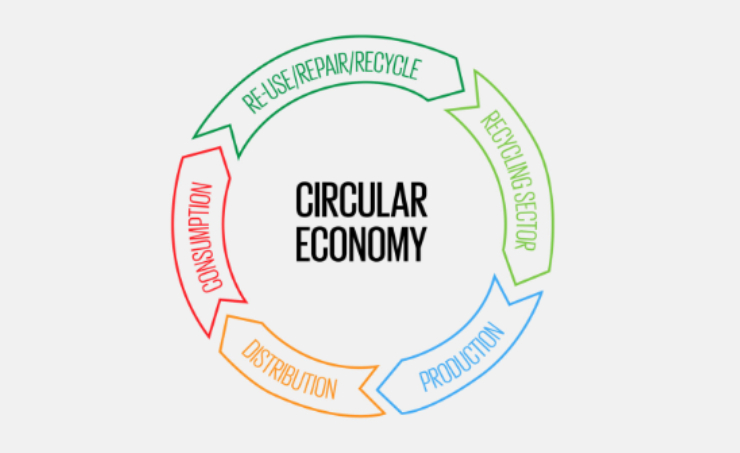The concept of a circular economy has gained significant attention in recent years as a sustainable alternative to the linear take-make-dispose model. It aims to decouple economic growth from resource depletion and environmental degradation. This blog will explore the genesis of the circular economy, its importance in addressing pressing global challenges and outline the way forward towards its implementation. Additionally, it will provide examples of successful initiatives that demonstrate the practical application of circular economy principles.
Genesis of the Circular Economy
The genesis of the circular economy gets traced back to the recognition of the finite nature of resources and the unsustainability of the prevailing linear consumption model. In the 1960s, economists Kenneth Boulding and Herman Daly emphasised the need for an economy operating within ecological limits. Their ideas laid the foundation for the modern concept of a circular economy.
The concept gained further prominence in the 2000s when the Ellen MacArthur Foundation, established by the renowned sailor Dame Ellen MacArthur, championed the idea. The foundation highlighted the potential of circularity in reducing waste, conserving resources and promoting economic resilience.
Importance of the Circular Economy
The circular economy is of paramount importance in tackling pressing global challenges. Firstly, it addresses resource scarcity by promoting the efficient use and recycling of materials, thus reducing reliance on finite resources. It reduces the pressure on ecosystems and helps to preserve biodiversity.
Secondly, the circular economy reduces waste generation and associated environmental pollution. By adopting strategies such as recycling, remanufacturing and sharing platforms, the circular economy minimises the extraction of raw materials and the production of waste. It significantly reduces greenhouse gas emissions and air and water pollution, contributing to climate change mitigation and improved environmental quality.
Thirdly, the circular economy offers economic benefits. It fosters innovation, job creation and the development of new business models. Closing the loop and retaining the value of products and materials within the economy reduces dependence on volatile commodity prices and increases economic resilience. This shift towards a circular system can stimulate economic growth while minimising environmental impacts.
The Way Forward: Examples of Circular Economy Initiatives
Several successful initiatives exemplify the way forward in implementing a circular economy. One example is the Dutch company Philips, which transitioned from selling lighting products to providing lighting as a service (McKinsey, 2014). Rather than selling light bulbs, Philips now offers lighting solutions where they retain ownership of the products, ensuring that materials are kept in use, repaired and upgraded when necessary.
Another example is the fashion industry, which has significantly contributed to resource depletion and waste. However, innovative initiatives, like the rental and subscription model, are emerging. The companies like Rent the Runway and Le Tote allow customers to rent clothing items (Subscriboxer, n.d.), reducing the need for constant production and ownership.
Furthermore, cities worldwide are into adopting circular economy principles to manage waste and create new economic opportunities. For instance, the City of San Francisco implemented a zero-waste policy intending to divert all waste from landfills by 2020. The city achieved a remarkable 80% diversion rate through recycling, composting and waste-to-energy initiatives, demonstrating the feasibility of a circular approach (CNBC, 2018).
The genesis of the circular economy gets traced back to the unsustainability of the linear consumption model’s recognition. Embracing a circular economy is crucial for addressing global challenges such as resource scarcity, waste generation and environmental degradation. The circular economy offers a sustainable pathway forward by adopting strategies that promote the efficient use of resources, waste reduction and economic resilience. Successful initiatives in various sectors, such as Philips’ lighting-as-a-service model and fashion rentals, give further impetus to support businesses with evident green practices, such as circular business models, because, by 2025, more than 40% of customers will adjust their buying behaviour (Forbes, 2022).
Bibliography
1. CNBC, 2018. Technology. [Online]
Available at: https://www.cnbc.com/2018/07/13/how-san-francisco-became-a-global-leader-in-waste-management.html
[Accessed 31 May 2023].
2. Forbes, 2022. Innovation. [Online]
Available at: https://www.forbes.com/sites/cognizant/2022/04/21/the-circular-economy-is-coming-here-are-three-ways-to-prepare/?sh=4766806b46bd
[Accessed 31 May 2023].
3. McKinsey, 2014. Our Insights. [Online]
Available at: https://www.mckinsey.com/capabilities/sustainability/our-insights/toward-a-circular-economy-philips-ceo-frans-van-houten
[Accessed 31 May 2023].
4. Subscriboxer, n.d. [Online]
Available at: https://subscriboxer.com/le-tote-vs-rent-the-runway/
[Accessed 31 May 2023].
5. Image Source- WDO, 2020. [Online]
Available at: https://wdo.org/designing-towards-circular-economy/
[Accessed 31 May 2023].

